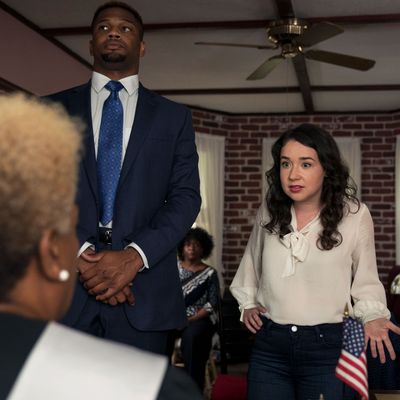
In last year’s excellent documentary Boys State (which might have been a phenomenon, incidentally, had it not been for the pandemic and had Apple TV+ not siloed it off for subscribers only), the teenagers at the title camp in Austin are separated into two parties and challenged to spend a week forming a representative state government, which means building coalitions and offering candidates for various posts, including governor. The boys are mostly free to do as they please, but they’re warned not to advance a platform around Texas seceding from the United States, which had gotten the camp the wrong kind of press in 2017. As Jonathan Coulton sings in his hilariously abbreviated secession explainer on this week’s inspired episode, “It’s boring and it’s dumb, end of song.”
And so the idea does get shot down in Boys State, but the sentiment survives, carried forward by a pack of caterwauling teenagers who have the instinct to turn this weeklong civics lesson into Lord of the Flies. With that, the film says something about our fraught political times: For some, the democratic experiment is only worth tolerating insofar as it advances their agenda. If gloves-off politics isn’t enough to win power, then the second option is to delegitimize the process entirely. The thing about democracy is that all sides need to be committed to respecting its norms and ideals. But there’s always going to be a contingent of (loud) voices that blow the whole thing up. That’s what the January 6 insurrection was all about.
This lively, if shambling, fifth season of The Good Fight has been leading to this moment when the institutions that define this country and reinforce the rule of law come under question. When the issue of secession is brought before Judge Wackner, he bears witness to the dark side of his own radical experiment, which started with him rejecting a justice system that wasn’t working for ordinary citizens and now ends in his own makeshift court getting ransacked. He and the secessionists are two sides of the same coin: rugged individualists in a country where the legitimacy of government institutions is undermined by those who feel disenfranchised by them. The secessionists, led by the right-wing moneyman David Cord, feel like they’ve taken their case for halving the state of Illinois to the right place. After all, if Wackner is able to thumb his nose at the justice system, why wouldn’t he respect a plan to cleave downstate Illinoisans from the Chicago city slickers who frequently control the government? And on the off chance he doesn’t? Time to burn it all down.
“And the Violence Spread” suggests the insurrection as a stealth theme that’s been in the works all season long, like the inevitable end to one man’s righteous break from the mainstream. Judge Wackner is a little like Howard Beale in Network: There’s a point where “I’m mad as hell and I’m not going to take it anymore” went from a righteous call to arms to a grotesque three-ring circus on television, without Beale himself seeming to realize it. Wackner doesn’t understand until the last minute that the secessionist yahoos getting riled up in his courtroom will not respect a decision that doesn’t go their way, despite the seemingly made-up evidence of a legal case that a simple Google Translate can easily upend. The Capitol Hill insurrectionists didn’t care that the ludicrous case for voter fraud was rejected by courtroom after courtroom; they just weren’t going to accept any result that failed to give Donald Trump a second term.
The divisions within the country are reflected elsewhere in the episode, as Diane continues to cling to her name-partner position at Reddick Lockhart. The show has been exceptionally bold this season in casting Diane in an unflattering light — in her words, a “top Karen, the most entitled white woman on the planet.” She reminds Liz that they had agreed to pursue her career-long vision of a firm run entirely by women, which glides over the fact that this particular operation wants to be recognized as a Black-run firm. Remember that Diane was persona non grata when the firm agreed to bring her onboard, so the idea that she can come in and redefine it on her terms is offensive to many. She even pitches a secession plan within Reddick Lockhart itself, with Liz hiring half of the associates (presumably Black) and Diane hiring the other half (presumably white). The plan doesn’t go anywhere, but the image of a segregated office lingers for a bit.
Directed by co-creator Robert King, the episode has the stylistic brio of the day-in-the-life section of Goodfellas, where the frantic activity is reflected by breakneck energy and a restless camera. King wants to prime the viewer for the explosion of violence at the courtroom, coupled by a last-second meeting with the bigwigs at STR Laurie, who hold the firm’s fate in their hands and probably won’t want to hear about the divisions that have rendered it nearly dysfunctional. Then there’s the third problem of Oscar Rivi’s cannabis deal, which is put in jeopardy by his hair-trigger temper and the fates of three street dealers under his employ. Rivi is a cash cow for the firm, and if his lucrative contract with Plum Meadow goes south, that’s going to spoil its appeal to STR Laurie. The Good Fight is at its best when it’s a kind of controlled chaos, and King is the spirited ringleader of multiple complementary subplots here.
Though the Wackner court never quite panned out as well as it might have this season — too much silliness for its own sake, like the “purple zone” nonsense a couple of week ago — it does express two important ideas about the country at once: a feeling of disenfranchisement from the legal system and the weakening of once-trusted public institutions during the Trump administration. The ransacking of Wackner’s court happened for the same reason the storming of the Capitol on January 6 happened: People felt emboldened enough to believe they could succeed. And if they couldn’t succeed, they let it be known that they prefer chaos and violence to the shared ideals in which a society functions. King ends on multiple images of other Wackner-esque community courts popping up in garages, living rooms, and truck beds across the country, like a seed that he’s planted. It’s up to the viewer whether that’s an optimistic notion or not.
Hearsay
• All the episode titles this season, when put together, tell a story of sorts, save for the first episode, which is just called “Previously On …”. The rest of it goes like this: Once there was a court, and the court had a clerk, and the clerk had a firm, and the firm had two partners, and the two partners had a fight, and the fight had a détente, and the détente had an end, and the end was violent, and the violence spread.” Pretty clever for a show that enjoys its high-concept episode titles, like riffs on It’s Always Sunny in Philadelphia (“The Gang …”) and Friends (“The One Where …”).
• David Cord with a thesis of a line: “Insane is just one step away from reality if you get people to believe. And you know what makes people believe? TV.”
• “Didn’t Jesus say ‘Show me the evidence’?” Marissa’s effort to appeal to a Bible-thumping home judge goes about as well as expected.
• How wonderful to see Austin Pendleton make a cameo appearance here, especially in a courtroom, which will remind viewers of his excellent turn as a stuttering defense lawyer in My Cousin Vinny. His lawyer is wildly unpersuasive in a different way here.
• Diane and Kurt snacking on marijuana gummies fondly recalls the season when Diane was microdosing. Sometimes she needs to take the edge off.


